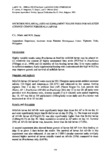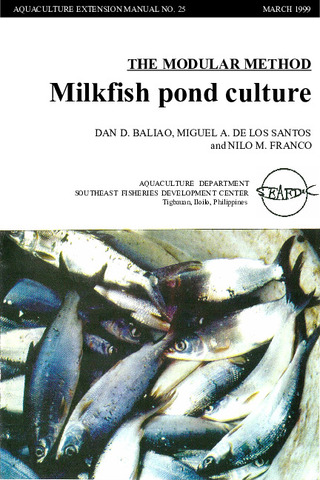Microbound larval feed as supplement to live food for milkfish (Chanos chanos Forsskal) larvae
- Global styles
- MLA
- Vancouver
- Elsevier - Harvard
- APA
- Help

View/
Date
1991Page views
7,547ASFA keyword
AGROVOC keyword
Taxonomic term
Metadata
Show full item record
Share
Abstract
Highly variable results using Brachionus as food for milkfish (Chanos chanos) larvae may be related to: (1) relatively low content of highly unsaturated fatty acids (HUFAs) in Brachionus and (2) inability of first feeding larvae (day 2) to ingest rotifers in sufficient numbers. Early supplemental feeding with a microbound diet high in HUFAs may improve growth and survival of milkfish larvae.
Suggested Citation
Marte, C. L., & Duray, M. N. (1991). Microbound larval feed as supplement to live food for milkfish (Chanos chanos Forsskal) larvae. In P. Lavens, P. Sorgeloos, E. Jaspers, & F. Ollevier (Eds.), Larvi ’91 - Fish & Crustacean Larviculture Symposium (pp. 175-177). Gent, Belgium: European Aquaculture Society.
Type
Conference paperCollections
- Conference Proceedings [298]
Related items
Showing items related by title, author, creator and subject.
-
Series: Aquaculture extension manual; No. 25
The modular method: Milkfish pond culture
Baliao, Dan D.; de los Santos, Miguel A.; Franco, Nilo M. (Aquaculture Department, Southeast Asian Fisheries Development Center, 1999)The modular method of milkfish culture (Chanos chanos) described in the manual is an improvement over the traditional extensive method. The manual is intended for the use of fish farmers and aquaculturists, extensionists, ... -
Evaluation of organic and inorganic fertilizers in brackishwater milkfish ponds
Bombeo-Tuburan, Isidra; Agbayani, Renato F.; Subosa, Precilla F. (Elsevier, 1989)The study was conducted in twelve 144-m2 ponds to evaluate the effect of different organic and inorganic fertilizers on the growth, survival, gross production, and profitability of marketable milkfish. The ... -
Milkfish breeding and hatchery technology at SEAFDEC/AQD
Unknown author (Aquaculture Department, Southeast Asian Fisheries Development Center, 1999)Describes the techniques already adopted by the private sector: broodstock management, broodstock diet, commercial fry production, live transport, and larval diet. A list of AQD research publications on milkfish is included.





